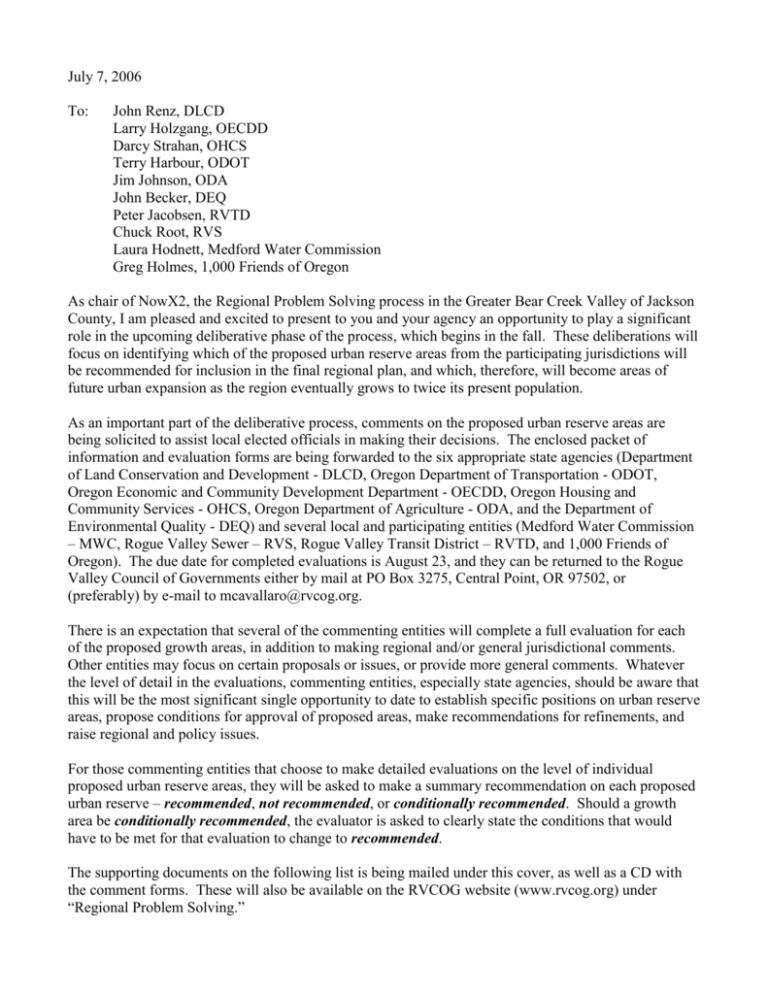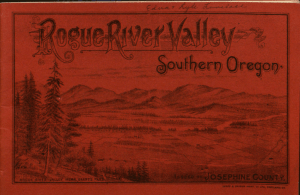NowX2, The Regional Problem Solving (RPS) process for the
advertisement

July 7, 2006 To: John Renz, DLCD Larry Holzgang, OECDD Darcy Strahan, OHCS Terry Harbour, ODOT Jim Johnson, ODA John Becker, DEQ Peter Jacobsen, RVTD Chuck Root, RVS Laura Hodnett, Medford Water Commission Greg Holmes, 1,000 Friends of Oregon As chair of NowX2, the Regional Problem Solving process in the Greater Bear Creek Valley of Jackson County, I am pleased and excited to present to you and your agency an opportunity to play a significant role in the upcoming deliberative phase of the process, which begins in the fall. These deliberations will focus on identifying which of the proposed urban reserve areas from the participating jurisdictions will be recommended for inclusion in the final regional plan, and which, therefore, will become areas of future urban expansion as the region eventually grows to twice its present population. As an important part of the deliberative process, comments on the proposed urban reserve areas are being solicited to assist local elected officials in making their decisions. The enclosed packet of information and evaluation forms are being forwarded to the six appropriate state agencies (Department of Land Conservation and Development - DLCD, Oregon Department of Transportation - ODOT, Oregon Economic and Community Development Department - OECDD, Oregon Housing and Community Services - OHCS, Oregon Department of Agriculture - ODA, and the Department of Environmental Quality - DEQ) and several local and participating entities (Medford Water Commission – MWC, Rogue Valley Sewer – RVS, Rogue Valley Transit District – RVTD, and 1,000 Friends of Oregon). The due date for completed evaluations is August 23, and they can be returned to the Rogue Valley Council of Governments either by mail at PO Box 3275, Central Point, OR 97502, or (preferably) by e-mail to mcavallaro@rvcog.org. There is an expectation that several of the commenting entities will complete a full evaluation for each of the proposed growth areas, in addition to making regional and/or general jurisdictional comments. Other entities may focus on certain proposals or issues, or provide more general comments. Whatever the level of detail in the evaluations, commenting entities, especially state agencies, should be aware that this will be the most significant single opportunity to date to establish specific positions on urban reserve areas, propose conditions for approval of proposed areas, make recommendations for refinements, and raise regional and policy issues. For those commenting entities that choose to make detailed evaluations on the level of individual proposed urban reserve areas, they will be asked to make a summary recommendation on each proposed urban reserve – recommended, not recommended, or conditionally recommended. Should a growth area be conditionally recommended, the evaluator is asked to clearly state the conditions that would have to be met for that evaluation to change to recommended. The supporting documents on the following list is being mailed under this cover, as well as a CD with the comment forms. These will also be available on the RVCOG website (www.rvcog.org) under “Regional Problem Solving.” Final draft, Regional Economic Opportunities Analysis (ECONorthwest) Final draft, Regional Housing Analysis (ECONorthwest) Individual jurisdictional discussion papers on urban reserve proposals (“Rationale, Assumptions, and Constraints: The Narrative”) Individual jurisdictional calculations of present and proposed residential, commercial, and industrial lands capacity (“Rationale, Assumptions, and Constraints: The Numbers”) A powerpoint of the first round of transportation modeling by ODOT’s Transportation Planning and Analysis Unit (TPAU) A list of acreages of all proposed urban reserve areas Jurisdiction-level maps of all proposed urban reserve areas (two maps each, one with aerials as a background and the other with county zoning) community buffer areas, and RLRC recommended commercial agricultural resource base lands Jurisdiction-level maps of proposed percentage distribution of future urban uses (residential, institutional, open space, commercial, and industrial) in the proposed urban reserve areas. A powerpoint of the draft Base Case, which is a scenario of the most likely outcome of planning for double the population without deviating from the statewide planning rules. The NowX2 adopted Goals and Policies A copy of the December 2002 Mail Tribune Insert (good background material, outdated maps) Pertinent land use Statutes, OARs, and Goals Jackson County coordinated population numbers (ECONorthwest) NowX2’s draft allocation of the doubled population Evaluation forms (on a CD) In addition, if necessary, RVCOG will be able to provide individual maps of each proposed urban reserve area with assessor-level information (tax lot and acreage), should a commenting agency require that detailed information. Allow me to thank you on behalf of all of the participants in the NowX2 Regional Problem Solving process for the work you will be undertaking. After more than six years of work, the region is poised to begin deliberations on how the proposals now being made by its jurisdictions can be blended into a truly regional plan for future growth and livability in the Greater Bear Creek Valley. Your efforts in evaluating the work done to date will be invaluable in determining what that regional plan eventually becomes. Sincerely, Kate Jackson Policy Committee Chair Greater Bear Creek Valley Regional Problem Solving







